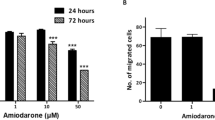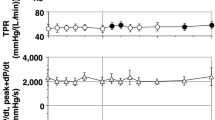Abstract
We have previously demonstrated that amiodarone is able to reverse resistance of rat colon cancer cells to anthracyclines. We now compare the efficiency of amiodarone to verapamil one, another antiarrhythmic agent used in experimental systems and in clinical trials to enhance the effects of anthracyclines on resistant cancer cells. Amiodarone is more efficient than verapamil when both drugs are used at the same molar concentrations. Desethylamiodarone, the main metabolite of amiodarone, is as efficient as its precursor. Optimal concentrations of amiodarone are obtained without side effects in the sera of patients treated by oral administration followed by a loading infusion of amiodarone. On the other hand, maximal tolerated levels of verapamil reported in clinical trials are less efficient than amiodarone maximal levels in the reversal of resistance to anthracyclines in our experimental model in vitro. We suggest that amiodarone, which is more efficient and less toxic than verapamil, could be substituted for verapamil in future clinical trials.
This is a preview of subscription content, access via your institution
Access options
Subscribe to this journal
Receive 24 print issues and online access
$259.00 per year
only $10.79 per issue
Buy this article
- Purchase on Springer Link
- Instant access to full article PDF
Prices may be subject to local taxes which are calculated during checkout
Similar content being viewed by others
Author information
Authors and Affiliations
Rights and permissions
About this article
Cite this article
Chauffert, B., Rey, D., Coudert, B. et al. Amiodarone is more efficient than verapamil in reversing resistance to anthracyclines in tumour cells. Br J Cancer 56, 119–122 (1987). https://doi.org/10.1038/bjc.1987.167
Issue Date:
DOI: https://doi.org/10.1038/bjc.1987.167
This article is cited by
-
A pilot study of amiodarone with infusional doxorubicin or vinblastine in refractory breast cancer
Cancer Chemotherapy and Pharmacology (1995)



